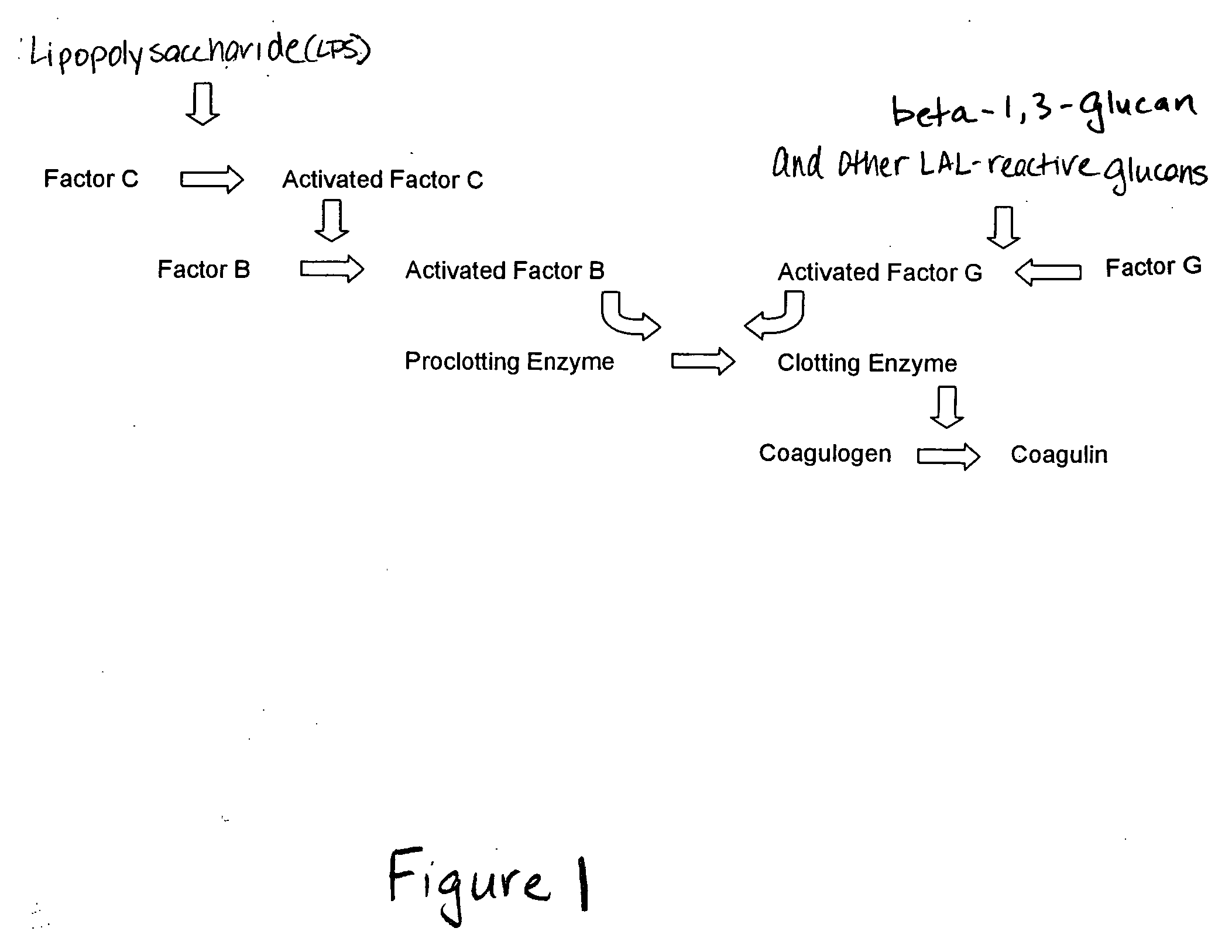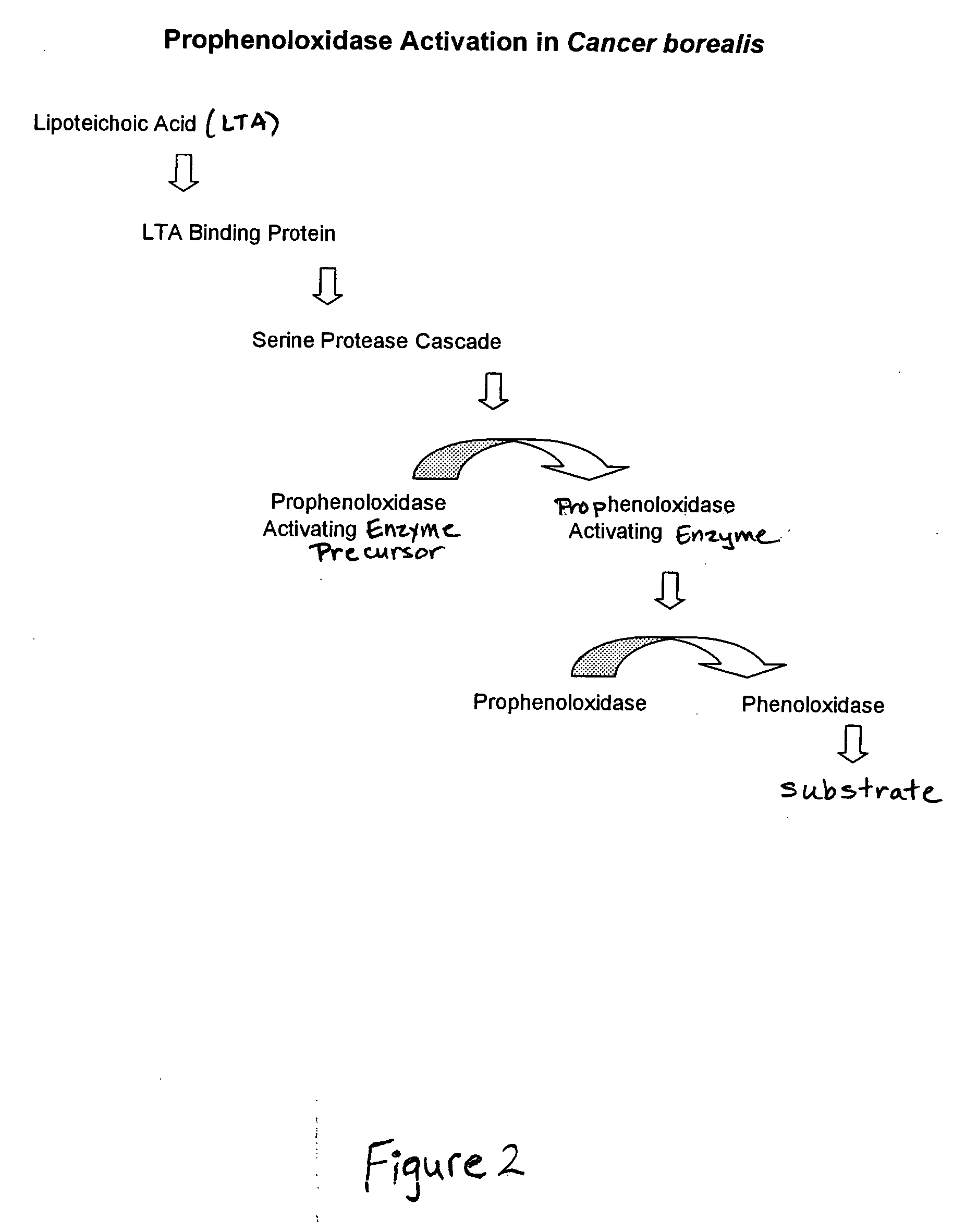Methods and compositions for the detection and/or quantification of gram positive bacterial contaminants
- Summary
- Abstract
- Description
- Claims
- Application Information
AI Technical Summary
Benefits of technology
Problems solved by technology
Method used
Image
Examples
example 1
Preparation of Lipoteichoic Acid Reactive Material from Cancer borealis
[0092] A preparation of lipoteichoic acid reactive material was made from Cancer borealis hemocytes by the following method.
[0093] The appearance of the crab was observed and recorded. Centrifuge tubes (50 mL) were labeled and placed on ice. A sterile 18 gauge needle was connected to the syringe in a sterile manner, and the syringe was filled with 5 mL of Bleed Solution (0.45 M sodium chloride, 0.1 M glucose, 30 μM sodium citrate, 26 μM citric acid, and 2.5 μM sodium EDTA, pH 4.6). The interior unsclerotized membrane of one of the crab's hind most legs was washed with 70% ethanol and dried with a sterile wipe. The needle was carefully inserted into the interior unsclerotized membrane of one of the washed hind legs. The crab was lifted above the needle and the syringe gently pulled to elicit blood flow. If no blood flowed into the syringe, the position of the needle was adjusted (e.g., moved deeper into the memb...
example 2
Protocol for Lipoteichoic Acid Assay
[0097] In this assay, a single-step kinetic assay was performed in a microtiter plate. In this assay, lipoteichoic acid (LTA) (L2515, Sigma Chemical Co., St. Louis, Mo.), was diluted to give a standard curve. The standard curve contained 3 fold serial dilutions starting from 60 μg / mL to 0.74 μg / mL in 0.2 M Tris buffer pH 7.4. Tris buffer (0.2 M, pH 7.4) was used as a negative control. Comparable standard curves were also created using peptidoglycan (77140, Fluka, Switzerland), glucan (glucan standard, Charles River Endosafe, Charleston, S.C.) and lipopolysaccharide (L-2637, Sigma Chemical Co., St. Louis, Mo.).
[0098] The C. borealis preparation used in this Example was prepared essentially as described in Example 1. However, the supernatant prior to testing for pro-phenyl oxidase activity was further purified as follows. Briefly, the supernatant was harvested and an equal volume of a saturated solution of ammonium sulfate was added to the superna...
example 3
Use of Cancer borealis Hemocyte Preparation for the Detection of Gram Positive Bacteria
[0101] In this Example, a Cancer borealis preparation produced according to Example 1 was used to detect the presence of Gram positive bacteria in test samples. In particular, in this Example, the reactivity of the preparation was tested against various Gram positive bacteria (including, Staphylococcus epidermidis, Bacillus subtilis, Bacillus pumilus, Bacillus megaterium and Deinococcus radiodurans), Gram negative bacteria (including, Escherichia coli, Pseudomonas stutzeri, Sphingomonas subarctica), Actinomyces (including Nocardiopsis antartica), and fungi (Aureobasidium pullulans).
[0102] In this example, the reactivity was assessed using a single-step kinetic assay implemented in a microtiter plate. In this assay, lipoteichoic acid (LTA) (L2515, Sigma Chemical Co., St. Louis, Mo.), was diluted to give a standard curve. The standard curve contained 5 fold serial dilutions starting from 100 μg / mL...
PUM
| Property | Measurement | Unit |
|---|---|---|
| Molar density | aaaaa | aaaaa |
| Molar density | aaaaa | aaaaa |
| Molar density | aaaaa | aaaaa |
Abstract
Description
Claims
Application Information
 Login to View More
Login to View More - R&D
- Intellectual Property
- Life Sciences
- Materials
- Tech Scout
- Unparalleled Data Quality
- Higher Quality Content
- 60% Fewer Hallucinations
Browse by: Latest US Patents, China's latest patents, Technical Efficacy Thesaurus, Application Domain, Technology Topic, Popular Technical Reports.
© 2025 PatSnap. All rights reserved.Legal|Privacy policy|Modern Slavery Act Transparency Statement|Sitemap|About US| Contact US: help@patsnap.com



